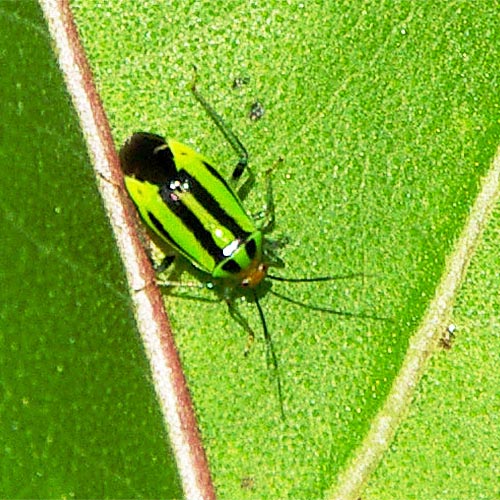Howdy, BugFans,
Most plant bugs (family Miridae) live well-camouflaged, unpublished, anonymous lives. Not so the Four-lined Plant Bug (Poecilocapsus lineatus).
The entomological Powers-That-Be have lumped the True Bugs (order Hemiptera) with the cicadas and their kin (the Bugs Formerly Known as Homoptera) to form a new, improved order Hemiptera. Inhabitants of the old order Hemiptera are now in the new suborder Heteroptera, and most members of the old order Homoptera are now in the new suborder Auchenorrhyncha (which the BugLady can neither spell nor pronounce), and the leftovers went into the suborder Sternorrhyncha (yes, there will be a quiz).
Four-lined Plant Bug
Miridae is the largest family in the Suborder Heteroptera, with 10,000+ family members (almost 2,000 in North America) that are variously called plant, grass, and leaf bugs. They have mouthparts that allow them to pierce plants and suck out the juices (though the family does include some piercing/sucking predators and omnivores), and the best-known species are those that feed on agricultural crops. Along with their signature Heteropteran mouthparts, Mirids also have trichobothria, which sounds like a nasty parasitic infestation but actually refers to special sensory hairs found on the hind two pairs of legs, hairs that “read” airborne currents and vibrations. Many Mirids are oval, small (less than a half-inch long), and drab, but some, like the ElPB are brightly-colored. The immature stages of some Mirid genera are ant mimics (myrmecomorphic), but little is known about them or about what the advantage is.
Not all adult FlPBs are green and black; some combine a yellow-orange background with black stripes; they may start life toward the yellow end of the spectrum and end up at the green one. The nymphs are red-orange and black. In all stages, their heads are orange. For a front view, see BugGuide’s Four-lined Plant Bug.
What are FlPBs famous for? The list of their plant foods includes about 270 species, starting with members of the mint family (many culinary herbs are mints), plus geraniums, chrysanthemums, snapdragons and others from the flower garden, plus crops like alfalfa, peas, lettuce, and squash, with some roadside/disturbed soil plants like dandelion, burdock, thistle and tansy thrown in for good measure. Woody plants are not excluded—FlPbs nibble on sumac, currants, dogwood, forsythia and viburnum, among others. Their faces are on Cooperative Extension Wanted Posters everywhere east of the Rockies. They damage, but generally do not kill, plants (smaller plants are more susceptible to harm) by sipping chlorophyll from between the upper and lower surfaces of the leaves, leaving small brown spots that may erode into holes. The brown spots on the leaves resemble a fungal infection, and since the FlPB typically ducks under a leaf, flies away, or falls to the ground when startled, its complicity is not initially suspected.
Clusters of “banana-shaped” FlPB eggs are inserted into two-to-three inch long slits in the upper stems of host plants before autumn, and they overwinter there as eggs, hatching in spring as the plant leafs out and reaching adulthood by summer. Like other Hemipterans, FlPBs have Simple/Incomplete metamorphosis, in which the immature insect (nymph) that emerges from the egg looks similar to an adult. It simply adds a few adult features like wings and reproductive organs as it grows and molts. Adults live for about a month.
Much of the information on-line concerns control methods, the caveat being that farmers and gardeners needn’t go after small populations of FlPBs. Before you reach for the heavy duty chemicals, try organic solutions like insecticidal soaps and hand-picking, along with destroying the egg masses in fall. Planting some mints as “trap crops” can redirect FlPbs from other species in the garden.
The BugLady
